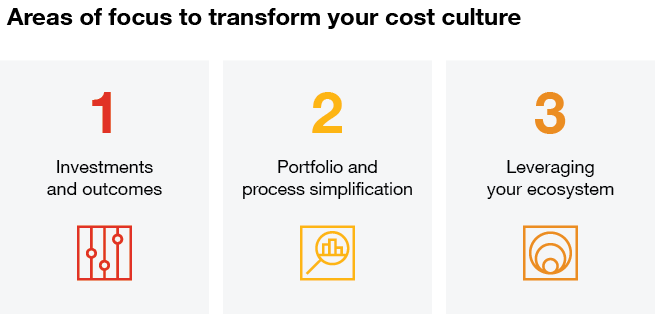{{item.title}}
{{item.text}}

{{item.text}}
After years of expanding operations, many CEOs are taking actions — in some cases precautionary ones — to cut costs. That’s understandable. Trimming expenses can often be the only reliable lever a CEO has to help meet short-term profit targets, and doing so can help protect the bottom line in an uncertain landscape.
Yet rapid cost cutting can pose two substantial risks:
Business functions — where the traditional “targets'' get assigned — often aren’t empowered to reimagine the organization. As a result, they tend to drive reactive cost reductions. That often means weakening the company by starving areas of future growth and leaving a disjointed, inefficient patchwork of cuts.
Focusing only on lowering expenses could be a missed chance to create lasting operational change that helps drive growth and increase value. It also can leave executives without a meaningful tradeoff of cutting costs to invest in growth. Such cuts tend to help only near-term profit margins, leaving a company that may need to make multiple reductions.
There’s another path for chief executives. You can institute a much bolder expense management change with the aim of strengthening your company’s strategic foundation. In this shift, the CEO’s goal is reorienting expense management toward creating a fit-for-growth mindset.
What’s the problem with many cost-cutting plans and quotas? They can often be blunt tools that give little consideration to an expense’s strategic value. Instead, CEOs should see costs as an investment in the business.
Expenses are the deployment of capital aimed at growing the company and shaping the future. A disciplined cost process tries to separate good investments from bad by valuing an expense from the standpoint of the company’s singular strategic strengths and future direction. Through this approach, CEOs can go beyond conventional questions about how much can be cut or what’s in the budget and coordinate with leadership teams to determine which spending is cross-functionally important and essential to growth.
This is the type of evolution CEOs tell us they must accomplish to help their firms thrive. In PwC’s 27th Annual Global CEO Survey, roughly two out of five executives said their organization will no longer be economically viable in ten years if it continues on its current course.
Here are three key questions CEOs should ask themselves and their leadership teams as they work to transform their company’s cost culture into an efficient and effective process that can work in various economic situations.
These aren’t the only actions you can take to reimagine your company’s cost culture. Digital investments provide an opportunity to go beyond automating current processes and rethink value chains, with even small projects paying dividends across an organization. Also, budgeting that is zero-based, allocated and evaluated across functions, and focused on critical capabilities indicates that your company is prioritizing efficiency in its cost management system.
But make no mistake: Cost management is front and center these days, and leaders have a choice. You can either take the cost containment approach, which might damage your growth strategy, or you can reassess the core of how you operate and manage the organization by putting cost transformation at the center and letting it lead to bold steps toward simplification. These activities may not only be a better way to manage costs; they can be a better way to transform your company and help shape its future.
{{item.text}}

{{item.text}}

